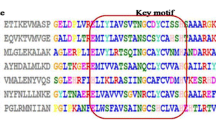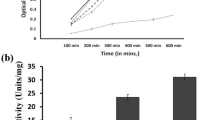Abstract
This paper constitutes the first report on the Alr1105 of Anabaena sp. PCC7120 which functions as arsenate reductase and phosphatase and offers tolerance against oxidative and other abiotic stresses in the alr1105 transformed Escherichia coli. The bonafide of 40.8 kDa recombinant GST+Alr1105 fusion protein was confirmed by immunoblotting. The purified Alr1105 protein (mw 14.8 kDa) possessed strong arsenate reductase (Km 16.0 ± 1.2 mM and Vmax 5.6 ± 0.31 μmol min−1 mg protein−1) and phosphatase activity (Km 27.38 ± 3.1 mM and Vmax 0.077 ± 0.005 μmol min−1 mg protein−1) at an optimum temperature 37 °C and 6.5 pH. Native Alr1105 was found as a monomeric protein in contrast to its homologous Synechocystis ArsC protein. Expression of Alr1105 enhanced the arsenic tolerance in the arsenate reductase mutant E. coli WC3110 (∆arsC) and rendered better growth than the wild type W3110 up to 40 mM As (V). Notwithstanding above, the recombinant E. coli strain when exposed to CdCl2, ZnSO4, NiCl2, CoCl2, CuCl2, heat, UV-B and carbofuron showed increase in growth over the wild type and mutant E. coli transformed with the empty vector. Furthermore, an enhanced growth of the recombinant E. coli in the presence of oxidative stress producing chemicals (MV, PMS and H2O2), suggested its protective role against these stresses. Appreciable expression of alr1105 gene as measured by qRT-PCR at different time points under selected stresses reconfirmed its role in stress tolerance. Thus the Alr1105 of Anabaena sp. PCC7120 functions as an arsenate reductase and possess novel properties different from the arsenate reductases known so far.









Similar content being viewed by others
References
Anderson CR, Cook GM (2004) Isolation and characterization of arsenate-reducing bacteria from arsenic-contaminated sites in New Zealand. Curr Microbiol 48:341–347
Bobrowicz P, Wysocki R, Owsianik G, Goffeau A, Ulaszewski S (1997) Isolation of three contiguous genes, ACR1, ACR2, and ACR3, involved in resistance to arsenic compounds in the yeast Saccharomyces cerevisiae. Yeast 13:819–828
Carlin A, Shi W, Dey S, Rosen BP (1995) The ars operon of Escherichia coli confers arsenical and antimonial resistance. J Bacteriol 177:981–986
Chaurasia N, Mishra Y, Rai LC (2008) Cloning, expression and analysis of phytochelatin synthase (pcs) gene from Anabaena sp. PCC 7120 offering multiple stress tolerance in Escherichia coli. Biochem Biophys Res Commun 376:225–230
Chen CM, Misra TK, Silver S, Rosen BP (1986) Nucleotide sequence of the structural gene of an anion pump. The plasmid-encoded arsenical resistance operon. J Biol Chem 261:15030–15038
Dhankher OP, Shastil NA, Rosen BP, Fuhrmann M, Meagher RB (2003) Increased cadmium tolerance and accumulation by plants expressing bacterial arsenate reductase. New Phytol 159:431–441
Dixit AR, Dhankher OP (2011) A novel stress-associated protein ‘AtSAP10’ from Arabidopsis thaliana confers tolerance to nickel, manganese, zinc, and high temperature stress. PLoS ONE 6(6):e20921. doi:10.1371/journal.pone.0020921
Duan G-L, Zhou Y, Yi-Ping T, Mukhopadhyay R, Rosen BP, Zhu Y-G (2007) A CDC25 homologue from rice functions as an arsenate reductase. New Phytol 174:311–321
Ellis DR, Gumaelius L, Indriolo E, Pickering IJ, Banks JA, Salt DE (2006) A novel arsenate reductase from the arsenic hyperaccumulating fern Pteris vittata. Plant Physiol 141:1544–1554
Gladysheva TB, Oden KL, Rosen BP (1994) Properties of the arsenate reductase of plasmid R773. Biochemistry 33:7288–7293
Houot L, Floutier M, Marteyn B, Michaut M, Picciocch A, Legrain P, Aude J-C, Cassier-Chauvat C, Chauvat F (2007) Cadmium triggers an integrated reprogramming of the metabolism of Synechocystis PCC6803, under the control of the Slr1738 regulator. BMC Genomics 8:350
Imlay JA (2002) How oxygen damages microbes: oxygen tolerance and obligate anaerobiosis. Adv Microb Physiol 46:111–153
Jeffery CJ (1999) Moonlighting proteins. Trends Biochem Sci 24:8–11
Ji G, Silver S (1992) Reduction of arsenate to arsenite by the ArsC protein of the arsenic resistance operon of Staphylococcus aureus plasmid pI258. Proc Natl Acad Sci USA 89:9474–9478
Ji G, Garber EAE, Armes LG, Chen CM, Fuchs JA, Silver S (1994) Arsenate reductase of Staphylococcus aureus plasmid pI258. Biochemistry 33:7294–7299
Li R, Haile JD, Kennelly PJ (2003) An arsenate reductase from Synechocystis sp. strain PCC 6803 exhibits a novel combination of catalytic characteristics. J Bacteriol 185:6780–6789
Li H, Singh AK, McIntyre LM, Sherman LA (2004) Differential gene expression in response to hydrogen peroxide and the putative PerR regulon of Synechocystis sp. Strain PCC 6803. J Bacteriol 186:3331–3345
Liu J, Gladysheva TB, Lee L, Rosen BP (1995) Identification of an essential cysteine residue in the ArsC arsenate reductase of plasmid R773. Biochemistry 34:13472–13476
Lopez-Maury L, Florencio FJ, Reyes JC (2003) Arsenic sensing and resistance system in the cyanobacterium Synechocystis sp. Strain PCC 6803. J Bacteriol 185:5363–5371
Lopez-Maury L, Sanchez-Riego AM, Reyes JC, Florencio FJ (2009) The glutathione/glutaredoxin system is essential for arsenate reduction in Synechocystis sp. Strain PCC 6803. J Bacteriol 191:3534–3543
Messens J, Hayburn G, Desmyter A, Laus G, Wyns L (1999) The essential catalytic redox couple in arsenate reductase from Staphylococcus aureus. Biochemistry 38:16857–16865
Messens J, Martins JC, Brosens E, Van Belle K, Jacobs DM, Willem R, Wyns L (2002) Kinetics and active site dynamics of Staphylococcus aureus arsenate reductase. J Biol Inorg Chem 7:146–156
Mishra Y, Chaurasia N, Rai LC (2009) AhpC (alkyl hydroperoxide reductase) from Anabaena sp. PCC 7120 protects Escherichia coli from multiple abiotic stresses. Biochem Biophys Res Commun 38:606–611
Mukhopadhyay R, Rosen BP (1998) Saccharomyces cerevisiae ACR2 gene encodes an arsenate reductase. FEMS Microbiol Lett 168:127–136
Mukhopadhyay R, Rosen BP (2001) The phosphatase C(X)5R motif is required for catalytic activity of Saccharomyces cerevisiae Acr2p arsenate reductase. J Biol Chem 276:34738–34742
Mukhopadhyay R, Rosen BP (2002) Arsenate reductases in prokaryotes and eukaryotes. Environ Health Perspect 110:745–748
Mukhopadhyay R, Shi J, Rosen BP (2000) Purification and characterization of ACR2p, the Saccharomyces cerevisiae arsenate reductase. J Biol Chem 275:21149–21157
Musumeci L, Bongiorni C, Tautz L, Edwards RA, Osterman A, Perego M, Mustelin T, Bottini N (2005) Low-molecular-weight protein tyrosine phosphatases of Bacillus subtilis. J Bacteriol 187:4945–4956
Narayan OP, Kumari N, Rai LC (2010) Heterologous expression of Anabaena PCC 7120 all3940 (a Dps family gene) protects Escherichia coli from nutrient limitation and abiotic stresses. Biochem Biophys Res Commun 394:163–169
Oden KL, Gladysheva TB, Rosen BP (1994) Arsenate reduction mediated by the plasmid-encoded ArsC protein is coupled to glutathione. Mol Microbiol 12:301–306
Oremland RS, Stolz JF (2005) Arsenic, microbes and contaminated aquifers. Trends Microbiol 13:45–49
Pandey S, Rai R, Rai LC (2012) Proteomics combines morphological, physiological and biochemical attributes to unravel the survival strategy of Anabaena sp. PCC7120 under arsenic stress. J Proteomics 75:921–937
Ramponi G, Stefani M (1997a) Structural, catalytic, and functional properties of low Mr phosphotyrosine protein phosphatases. Evidence of a long evolutionary history. Int J Biochem Cell Biol 29:279–292
Ramponi G, Stefani M (1997b) Structure and function of the low Mr phosphotyrosine protein phosphatates. Biochim Biophys Acta 1341:137–156
Rippka R, Deruelles J, Waterbury JB, Herdman M, Stanier RY (1979) Generic assignments, strain histories and properties of pure cultures of cyanobacteria. J Gen Microbiol 111:1–6
Rusnak F, Reiter T (2000) Sensing electrons: protein phosphatase redox regulation. Trends Biochem Sci 25:527–529
Sambrook J, Russell DW (2001) Molecular cloning: A laboratory manual. Cold Spring Harbor Laboratory Press, Cold Spring Harbor, NY
Sauge-Merle S, Cuine′ S, Carrier P, Lecomte-Pradines C, Luu D-T, Peltier G (2003) Enhanced toxic metal accumulation in engineered bacterial cells expressing Arabidopsis thaliana phytochelatin synthase. Appl Environ Microbiol 69:490–494
Shi J, Vlamis-Gardikas AF, Holmgren A, Rosen BP (1999) Reactivity of glutaredoxins 1, 2, and 3 from Escherichia coli shows that glutaredoxin 2 is the primary hydrogen donor to ArsC-catalyzed arsenate reduction. J Biol Chem 274:36039–36042
Shrivastava AK, Pandey S, Singh PK, Rai S, Rai LC (2012) alr0882 encoding a hypothetical protein of Anabaena PCC7120 protects Escherichia coli from nutrient starvation and abiotic stresses. Gene 511:248–255
Srivastava AK, Ara A, Bhargava P, Mishra Y, Rai SP, Rai LC (2007) A rapid and cost effective method of genomic DNA isolation from cyanobacterial culture, mat and soil suitable for genomic fingerprinting and community analysis. J Appl Phycol 19:373–382
Zegers I, Martins JC, Willem R, Wyns L, Messens J (2001) Arsenate reductase from S. aureus plasmid pI258 is a phosphatase drafted for redox duty. Nat Struct Biol 8:843–847
Zhou Y, Bhattacharjee H, Mukhopadhyay R (2006) Bifunctional role of the leishmanial antimonate reductase LmACR2 as a protein tyrosine phosphatase. Mol Biochem Parasitol 148:161–168
Acknowledgments
L.C. Rai is thankful to the Department of Science and Technology New Delhi for J.C. Bose National Fellowship and the University Grant Commission for financial assistance through a project. Sarita Pandey, Rashmi Rai and Alok Kumar Shrivastava thank the Council of Scientific and Industrial Research for SRF. We thank Prof. B.P. Rosen, Department of Cellular Biology and Pharmacology, Florida International University, Herbert Wertheim College of Medicine, Miami, Florida-33199, USA for providing E. coli W3110 and WC3110 strain and to the Head, and the Programme Coordinator Centre of Advanced Study in Botany, Banaras Hindu University,Varanasi, India for facilities and DBT-BHU ISLS for MALDI-TOF/MS analysis.
Author information
Authors and Affiliations
Corresponding author
Rights and permissions
About this article
Cite this article
Pandey, S., Shrivastava, A.K., Rai, R. et al. Molecular characterization of Alr1105 a novel arsenate reductase of the diazotrophic cyanobacterium Anabaena sp. PCC7120 and decoding its role in abiotic stress management in Escherichia coli . Plant Mol Biol 83, 417–432 (2013). https://doi.org/10.1007/s11103-013-0100-x
Received:
Accepted:
Published:
Issue Date:
DOI: https://doi.org/10.1007/s11103-013-0100-x




